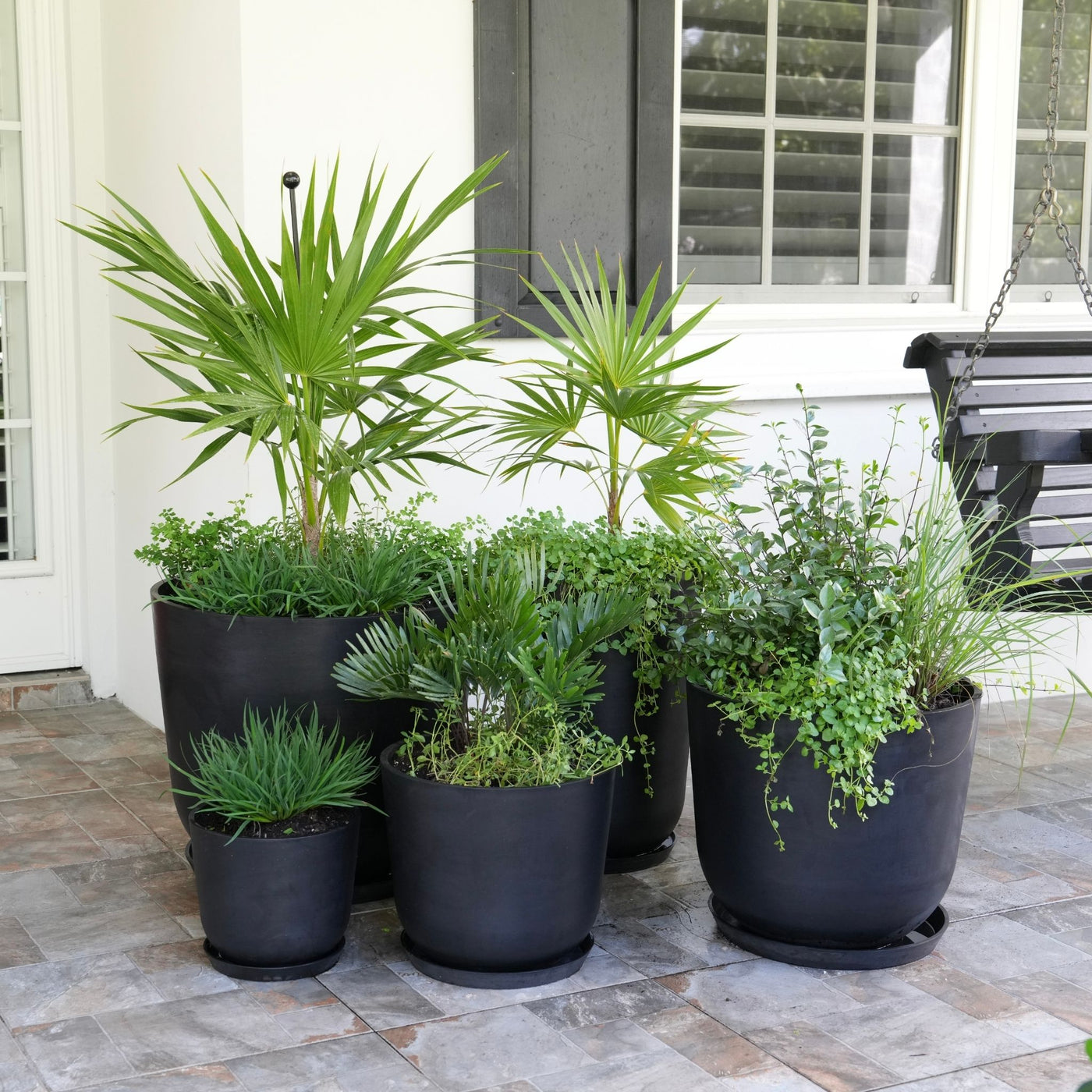Forest Whisper
This lush arrangement supports the endangered Atala and Leafwing butterflies. We've named our company and designed our logo in their honor.

How to water your native plants
Check the soil with your finger—if the top inch feels dry, it’s time to water!
1. In the morning, use room temp water
And avoid wetting leaves directly to help prevent disease.
2. In extreme heat, check moisture often
Check every 2-3 days. Plants go through more water when it’s hot.
3. Water deeply, and less frequently
A deep water ensures that lower roots get watered as well.
4. Use your 2 gallon watering can
Leave about 3.5 inches (4 fingers) unfilled to prevent spills.
| Planter size, Amount |
|---|
| X-Large Planter, 1 full watering can |
| Large & High Planter, ¾ watering can |
| Medium Planter, ½ watering can |
| Small Planter, ¼ watering can |
| Planter Size/Amount |
|---|
| X-Large Planter 1 full watering can |
| Large & High Planter ¾ watering can |
| Medium Planter ½ watering can |
| Small Planter ¼ watering can |
Sunlight Requirements
Your Forest Whisper Garden enjoys the shade (less than 3 hours of direct sunlight daily).


To learn more about sunlight and potential issues, jump to Common issues & solutions down below.
Seasonal Growth & Pruning
Some native plants are naturally low-maintenance and don’t require pruning. The following plants benefit from seasonal trimming to maintain their health and shape.
| Plant | Pruning |
|---|---|
| Thatch Palm | Trim dead fronds occasionally to maintain shape. |
| Maidenhair Fern | Trim dead fronds regularly for a neat appearance. |
| Blue-eyed Grass | Cut back after flowering to encourage healthy growth. |
| Fakahatchee Grass | Trim back any unruly growth to maintain shape. |
| Browne's Savory | Deadhead flowers to encourage more blooms. |
| Pineland Snowberry | Trim lightly after flowering to maintain size. |
| Coontie | Trim any dead or yellowing fronds. |
| Plant/Pruning |
|---|
| Thatch Palm Trim dead fronds occasionally to maintain shape. |
| Maidenhair Fern Trim dead fronds regularly for a neat appearance. |
| Blue-eyed Grass Cut back after flowering to encourage healthy growth. |
| Fakahatchee Grass Trim back any unruly growth to maintain shape. |
| Browne's Savory Deadhead flowers to encourage more blooms. |
| Pineland Snowberry Trim lightly after flowering to maintain size. |
| Coontie Trim any dead or yellowing fronds. |
How to Prune Properly
Always wash your pruning tool with soap and water after each use to prevent the spread of plant diseases. If using kitchen scissors, make sure they are thoroughly cleaned before using them again for food preparation.
- Use sharp, clean gardening shears for the best results. A kitchen scissors can do the job for light trims, but a quality pair of garden shears will make pruning easier and more precise.
- Always cut just above a leaf node or where new growth is emerging to encourage healthy regrowth.
- Remove dead or damaged stems to improve airflow and plant health.
Common issues & solutions
| Issue | Cause | Solution |
|---|---|---|
| Wilting leaves | Lack of water | Water deeply and check soil moisture regularly. |
| Soft yellow leaves | Overwatering or poor drainage | Reduce frequency and ensure proper drainage. |
| Dry yellow leaves | Lack of water or excess sun | Move plants to a shadier spot to reduce stress from sun exposure. |
| Slow growth | Too much direct sunlight | Move plants to a shadier spot to reduce stress from sun exposure. |
| Holes in leaves | Insects like caterpillars or leaf-eating insects | Harmful caterpillars (armyworms or cutworms) can be removed by hand. For aphids & leaf-eating pests, use a strong spray of water or apply neem oil: spot-treat instead of spraying the entire plant, avoid flowers (as they are a nectar source), and spray only in the evening to avoid harming butterflies and pollinators. |
| Few or no flowers | Lack of pruning or too much shade | Light pruning and thinning to encourage better airflow. Move plants to a brighter, partial sun location if they are not flowering. |
| Issue/Cause/Solutions |
|---|
| Wilting leaves Lack of water Water deeply and check soil moisture regularly. |
| Soft yellow leaves Overwatering or poor drainage Reduce frequency and ensure proper drainage. |
| Dry yellow leaves Lack of water or excess sun Move plants to a shadier spot to reduce stress from sun exposure. |
| Slow growth Too much direct sunlight Move plants to a shadier spot to reduce stress from sun exposure. |
| Holes in leaves Insects like caterpillars or leaf-eating insects Harmful caterpillars (armyworms or cutworms) can be removed by hand. For aphids & leaf-eating pests, use a strong spray of water or apply neem oil: spot-treat instead of spraying the entire plant, avoid flowers (as they are a nectar source), and spray only in the evening to avoid harming butterflies and pollinators. |
| Few or no flowers Lack of pruning or too much shade Light pruning and thinning to encourage better airflow. Move plants to a brighter, partial sun location if they are not flowering. |
Contact us anytime! We’re here to support your journey.

